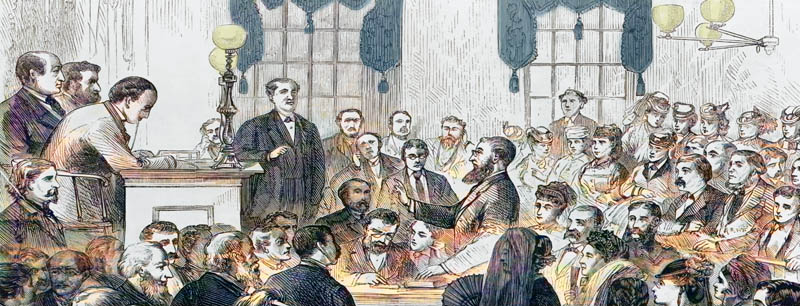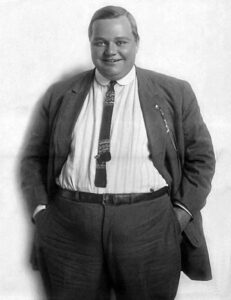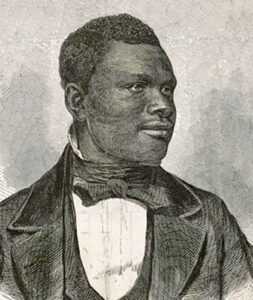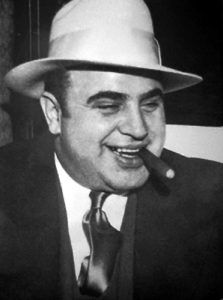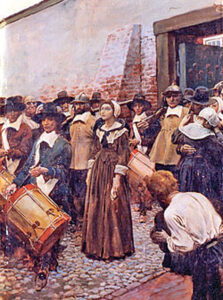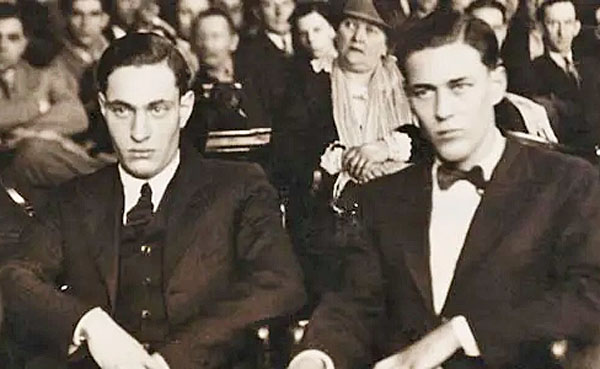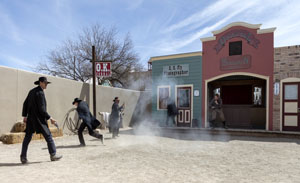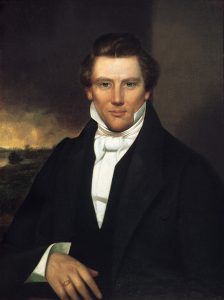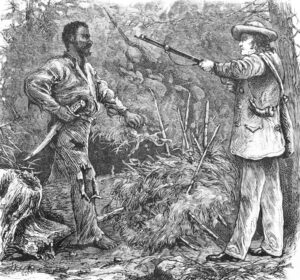Infamous trials throughout American History have created great theater for the masses. Some cases capture the public’s imagination and cause a media frenzy. Celebrity trials involve high-profile people, whether victims or defendants. Law and crime trials cover high-profile criminal trials, crazy crimes, celebrity justice, and innovative legal analysis. Political trials cover treason, spying, dissidents, and radicals. Many “whodunit” trials are surrounded by mystery. Here are a few of the famous trails in America.
Roscoe “Fatty” Arbuckle, San Francisco, California (1921) – One of the biggest silent film stars in American cinema was arrested in San Francisco for the rape and murder of Virginia Rappe, an aspiring actress he had invited to a party. Arbuckle maintained his innocence throughout numerous trials and was ultimately acquitted, but he was criticized in the press, and the case became a major Hollywood scandal.
Reverend Henry Ward Beecher, Brooklyn, New York (1875) – One of the biggest sex scandals of the 19th century, America’s leading moral and spiritual teacher and brother of famed abolitionist and author Harriet Beecher Stowe was accused by his closest friend, Theodore Tilton, of having an affair with Tilton’s wife, Elizabeth.
Lizzie Borden, New Bedford, Massachusetts (1893) – Borden went on trial for the axe murders of her father and stepmother before a jury of 12 men. In one of many shocking moments, Lizzie fainted after one of her lawyers revealed the skulls of her deceased parents in the courtroom.
John Brown, Charles Town, West Virginia (1859) – The abolitionist was tried for treason against the state of Virginia, inciting slaves to rebellion and murder after leading a failed attempt to initiate a slave insurrection in Harper’s Ferry, West Virginia. Essayist Henry David Thoreau delivered a memorable courtroom speech praising Brown as “a man of ideas and principles.” Brown was found guilty of all charges, sentenced to death, and was executed by hanging on December 2, 1859. He was the first person executed for treason in the United States.
Anthony Burns Fugitive Slave Trial, Boston, Massachusetts (1854) – Born into slavery, he grew up to become a Baptist and a “slave preacher.” In 1853, he escaped slavery and reached the free state of Massachusetts, where he started working in Boston. The following year, he was captured under the Fugitive Slave Act of 1850 and tried in court in Boston. Because the act was despised and fiercely resisted in Boston, Burns’s case attracted national publicity, including large demonstrations, protests, attacks, and violence. In the judge’s final decision, he admitted that he thought the Fugitive Slave Act was a disgrace, but his job was to uphold the law. Though Burns was returned to his owner in Virginia, he was eventually ransomed from slavery, with his freedom purchased by Boston sympathizers.
Aaron Burr, Richmond, Virginia (1807) – Burr was an American politician, businessman, lawyer, and Founding Father who served as the third vice president of the United States from 1801 to 1805 during Thomas Jefferson’s first presidential term. Three years after killing Alexander Hamilton in a duel, the former Vice President was accused of conspiracy against the United States after attempting to raise a small army in the Western frontier. Thought to have been helping Mexico overthrow Spanish power in the Southwest and attempting to steal land from the Louisiana Purchase, he was brought to trial on a charge of treason. Despite the full force of the Jefferson administration’s political influence thrown against him, Burr was acquitted.
Al Capone, Chicago, Illinois (1931) – The government charged “Public Enemy No. 1” with tax evasion and prohibition. The mobster pleaded guilty and bragged to the press that he had struck a deal for a light sentence. When the judge informed the court that he was not bound to any deal, Capone changed his plea to not guilty.
Chicago Black Sox Scandal, Chicago, Illinois (1921) – Eight Chicago White Sox baseball team members were tried for intentionally losing the 1919 World Series in exchange for money. The defendants included two of the team’s best players, “Shoeless” Joe Jackson and George “Buck” Weaver, who denied throwing the games.
Boston Massacre, Boston, Massachusetts (1770) – On March 5, 1770, nine British soldiers shot several people in a crowd of 300 to 400 people who were harassing them verbally and throwing various objects. It was heavily publicized as “a massacre” by leading Patriots such as Paul Revere and Samuel Adams. The British troops had been stationed there since 1768 to enforce unpopular Parliamentary legislation. At trial, two of the soldiers were found guilty of manslaughter, but the others were acquitted.
The Conspiracy of 1741, New York City, New York – Also known as the Slave Insurrection of 1741, this plot by slaves and poor whites to revolt and level New York City with a series of fires. During the court cases, the prosecution kept changing the grounds of the accusation, ending with linking the insurrection by Spaniards and other Catholics. In the end, 34 people were hanged, 30 of whom were black men and two white women, and 13 black men were burnt at the stake. The bodies of two supposed ringleaders, Caesar, a slave, and John Hughson, a white cobbler and tavern keeper, were displayed and left to rot in public. Another 84 men and women faced transportation to the brutal conditions of Caribbean slavery, while seven white men were pardoned on condition of entering permanent exile from New York.
Mary Barrett Dyer, Boston, Massachusetts (1659 and 1660) – On a spiritual quest, Mary Dyer traveled to Boston, Massachusetts, to Portsmouth and Newport, Rhode Island, and to the northwest coast of England, where she became an ardent member of a new religion — a Quaker, or a member of the Society of Friends as they were more formally known. Mary returned to America as a Quaker missionary, determined to spread the good news. Her missionary zeal would ultimately take her to the gallows in Puritan Boston and make her the first and only woman to be executed in America because of her religious beliefs.
Leo Frank, Atlanta, Georgia (1913) – The Jewish American businessman is placed on trial for the rape and murder of 13-year-old factory worker Mary Phagan. The trial was primarily based on the testimony of a janitor who was held in seclusion by order of the Solicitor General, Hugh M. Dorsey, six weeks prior. Doubts about Frank’s guilt swirl in the press.
Charles Guiteau, Washington, D.C. (1881) – President James Garfield’s assassin went on trial for his murder and was one of the first high-profile insanity cases in the United States. Guiteau acted bizarrely throughout the trial, cursing and insulting the judge, giving his testimony in epic poems, and soliciting legal advice from spectators in the courtroom.
Haymarket Riot and Trial, Chicago, Illinois (1886) – Headlines in Chicago newspapers cry out for vengeance against mostly immigrant workers believed to have inspired the riot that followed a bombing during a labor demonstration. In response, police, without a warrant, round up and arrest known socialists and anarchists. A Chicago grand jury indicts twelve people in connection with the riot, while the actual bomber remains a mystery.
“Big Bill” Haywood, Boise, Idaho (1907) – The war between the Western Federation of Miners and the Western Mine Owners’ Association in Idaho came to a climax when radical labor leader “Big Bill” Haywood was prosecuted for ordering the assassination of governor Frank Steunenberg. The trial exposed years of union violence and mine owners’ intimidation and corruption. Famed defense attorney Clarence Darrow argued on Haywood’s behalf.
Anne Hutchinson, Boston, Massachusetts (1637) – Anne Marbury Hutchinson was a Puritan spiritual advisor, religious reformer, and important participant in the Antinomian Controversy, which shook the infant Massachusetts Bay Colony from 1636 to 1638. Her strong religious convictions were at odds with the established Puritan clergy in Boston. Her popularity and charisma helped create a theological division that threatened the Puritan religious community in New England. She was eventually tried, convicted, and then banished from the colony with many of her supporters.
Leopold & Loeb Trial, Chicago, Illinois (1924) – The murder trial of two elitist college students who decided to commit the “perfect crime” shocks the nation as details emerge about how they kidnapped and murdered Bobby Franks, a 14-year-old boy. Defense attorney Clarence Darrow delivers a 12-hour-long plea to save his clients from the gallows.
Lincoln Assassination Conspirators, Washington, D.C. (1865) – President Andrew Johnson insisted on trying the eight conspirators before a nine-member military tribunal. The defendants were allowed to have lawyers and witnesses but were not allowed to testify themselves.
Lindbergh Baby Kidnapping Trial, Flemington, New Jersey (1935) – After a two-year investigation, German immigrant Bruno Hauptmann is arrested for the kidnapping and murder of the 20-month-old son of famed aviator Charles Lindbergh. The circumstantial case against Hauptmann lasted five weeks, and a parade of witnesses testified at the trial, including dramatic testimony from Lindbergh.
Mountain Meadows Massacre, Utah Territory (1875-1876) – In 1857, a Mormon militia murdered 120 Arkansas emigrants passing through Utah on their way to California. Eighteen years later, a series of published stories challenging Brigham Young’s response to the massacre led to renewed public interest. Still, only one man, John D. Lee, was prosecuted for the mass killings.
O.K. Corral, Tombstone, Arizona (1881) – The most famous gun battle of the Old West lasted roughly 30 seconds but left three men dead and three more wounded. The brothers Wyatt, Virgil, and Morgan Earp, along with Doc Holliday, went on trial for their involvement in the shootout.
Sacco & Vanzetti Trial, Boston, Massachusetts (1920-1921) – The two Italian immigrants and anarchists were accused of armed robbery and the murder of two men. Anti-immigrant and anti-radical sentiment ran high in America, and the case made international headlines.
Salem Witchcraft Trials (1692-1693) – In this series of hearings and prosecutions, more than 200 people were accused of witchcraft in colonial Massachusetts. Thirty people were found guilty and hanged. Another died under torture after refusing to enter a plea, and at least five people died in jail.
Scopes “Monkey Trial,” Dayton, Tennessee (1925) – Clarence Darrow took center stage while defending John Scopes, a Tennessee high school teacher who was arrested for teaching the theory of evolution in violation of the state’s recently passed Butler Act, which forbade teaching evolution at any state-funded school. A carnival atmosphere pervaded as the trial opened, with hundreds of people jammed in the courthouse, banners, refreshment stands, and performing sideshows lined the surrounding streets for the crowds.
Scottsboro Boys, Scottsboro, Alabama (1931-1937) – Nine young black men and boys, ages 12 to 19, stand accused of raping two young white women, 21-year-old Victoria Price and 17-year-old Ruby Bates, while traveling on a train through rural Alabama. Over a decade, the case led to many trials, convictions, reversals, and retrials.
Joseph Smith Murder, Carthage, Illinois (1845) – Founder and leader of the Latter Day Saint movement, Joseph Smith, and his brother, Hyrum Smith, were killed by a mob in Carthage, Illinois, on June 27, 1844, while awaiting trial in the town jail. As mayor of the city of Nauvoo, Illinois, Joseph Smith ordered the destruction of the facilities used to print the Nauvoo Expositor, a newly-established newspaper created by a group of non-Mormons and others who had seceded from Smith’s church. Smith ordered the press destroyed, leading to public outrage. The Smith brothers were arrested and jailed when an armed mob of 150-200 men stormed the building, and they were killed. Five men were indicted for the killings but were acquitted at a jury trial.
State of Missouri v. Celia, Callaway County, Missouri (1855) – After 19-year-old Celia, a slave on a Missouri farm, had repeatedly been raped by her owner for five years and bore two children during this time, rejected his advances when she was sick and pregnant for a third time. When he refused to back down, she clubbed him over the head with the stick, killing him. Celia was tried for the first-degree murder of her owner, Robert Newsom, convicted by a jury of twelve white men and sentenced to death. She was was hanged on December 21, 1855.
Harry Kendell Thaw, New York (1906) – The wealthy railroad heir with a history of mental illness shot and killed famed architect Stanford White on the rooftop of Madison Square Garden in a jealous rage over Thaw’s wife, Evelyn Nesbit. The high society crime and ensuing trials created a media frenzy.
Nat Turner’s Slave Rebellion, Southampton County, Virginia (1831) – Historically known as the Southampton Insurrection, this rebellion of enslaved Virginians occurred in Southampton County, Virginia, in August 1831. Led by Nat Turner, the rebels killed between 55 and 65 white people, making it the deadliest slave revolt for white people in U.S. history. The rebellion was suppressed within a few days at Belmont Plantation, but Turner survived in hiding for about six weeks afterward. Dozens of suspected rebels were tried in courts. Turner was tried on November 5, 1831, convicted, and sentenced to death. He was hanged on November 11, 1831. During the trial of others, 30 were convicted, 18 of which were hanged, while 12 were sold out of state. Only 15 were were acquitted. Of the five free Blacks tried for participation in the insurrection, one was hanged, while the others were acquitted.
United States v. The Amistad, Washington, D.C. (1841): Former President John Quincy Adams argued before the Supreme Court to secure the freedom of the African captives who rebelled against Spanish slave traders aboard the ship Amistad.
Gloria Vanderbilt, New York (1934) – At age 10, the young heiress of a multimillion-dollar family fortune was caught in a custody battle between her mother and her deceased father’s sister. Her aunt argued that Gloria’s mother’s lifestyle of extravagant spending and perverse sexual exploits was damaging to the young girl. The scandalous testimony of her mother’s servants made national headlines. Ultimately, Vanderbilt’s mother lost the battle, and Gloria became the ward of her aunt Gertrude.
Compiled by Kathy Alexander/Legends of America, March 2024.
Also See:
Gangsters, Mobsters & Outlaws of the 20th Century
Sources:
Library of Congress
Library of Congress -2
UMKC School of Law
Wikipedia

